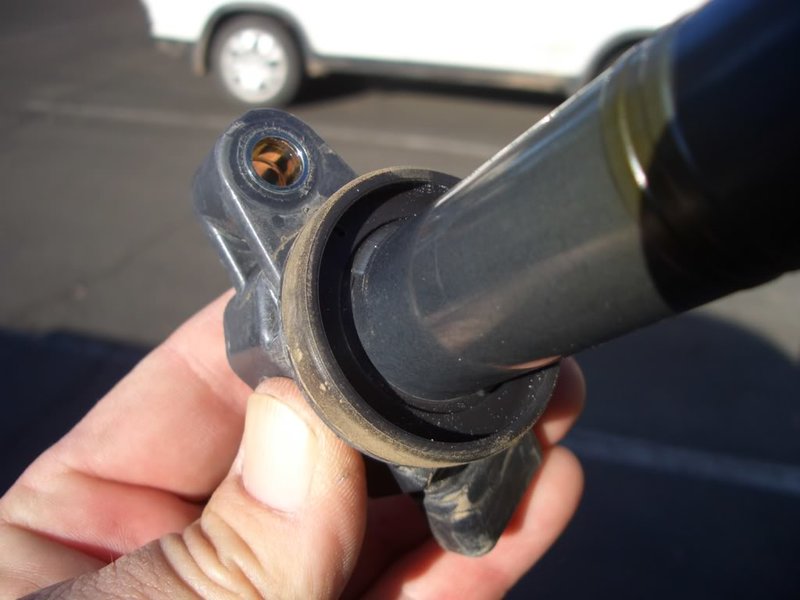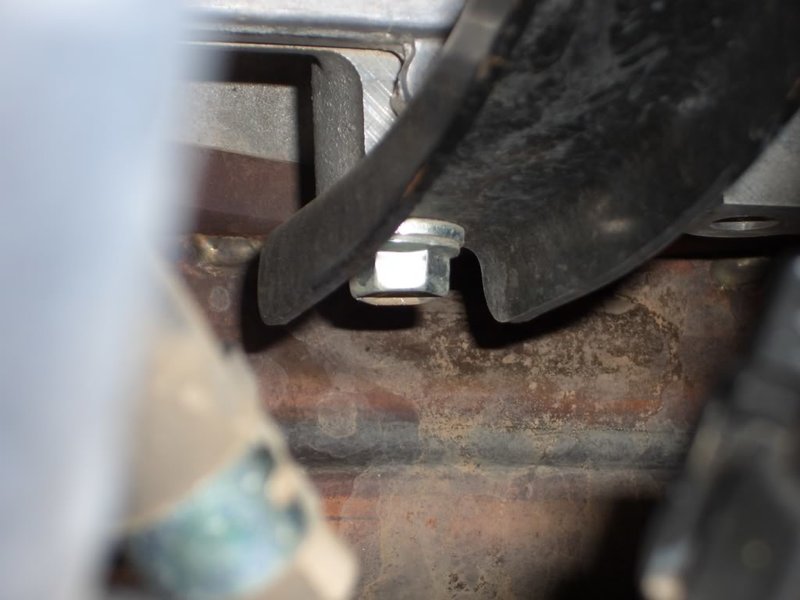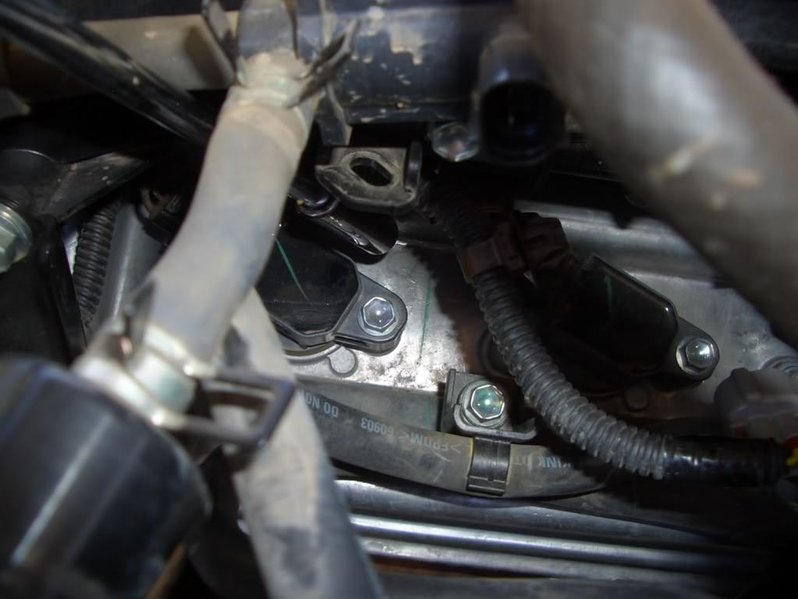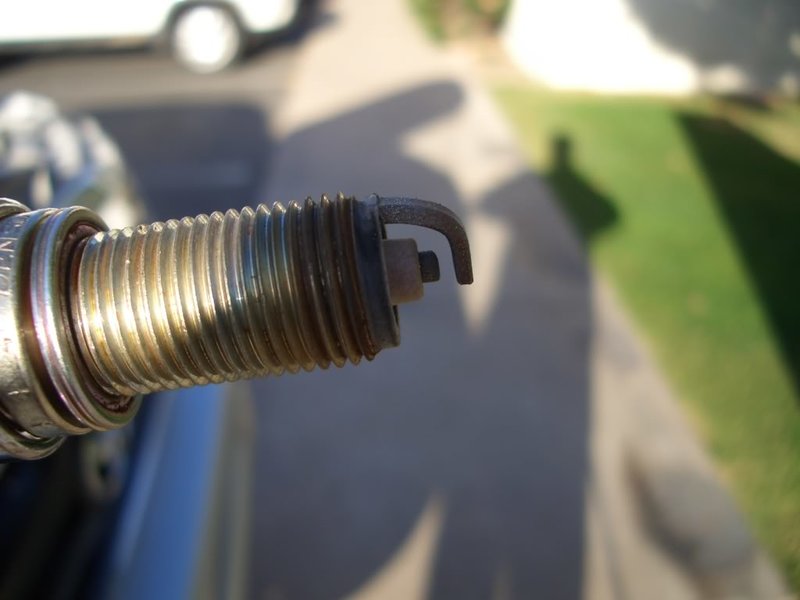Change the Spark Plugs on a 2005 Toyota Tacoma 4.0L V6 (1GR-FE Engine)
Works For:
2005 Toyota Tacoma 4.0L V6 (1GR-FE) Models
Source: TacomaWorld
Spark Plugs are recomended to be changed every 30,000 miles.
On average, it takes about 2 hours to change them if you take some breaks.
Give yourself 4 hours (or more, depending on how familliar you are with working on engines), if you have never done this before.
The Plugs for the 1GR-FE range in price from $2.50 to $6.00 each. I got mine from Toyota for $3.25 (each) + tax.
A tube of Anti-Sieze is about $5.00, but some places give you little packets of it when you buy the plugs.
Here is a “step-by-step” for changeing your spark plugs.
You only need a few hand tools to do this yourself:
5/8″ Spark Plug Socket
10mm socket (3/8″ and 1/4″)
12mm socket (3/8″ and 1/4″)
Long needle nose pliers (Not nessesary, but helps)
(2) 6″ extensions (3/8″)
(1) 3″ extension (3/8″)
3/8″ and 1/4″ ratchet
Spark Plug Gapper
Anti-Sieze
(6) Denso Spark Plugs #K20HR-U11 (Toyota part #90919-01235)
(1) 3/8″ Torque wrench
Spark Plug gap needs to be .039 to .043 (max)
Spark Plug Torque is 15 ft.-lbs.

Anti-Seize:
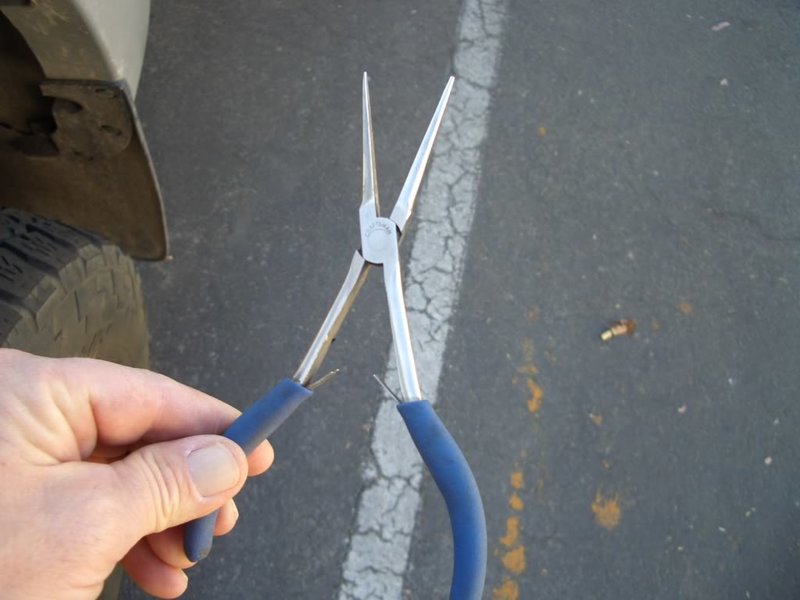
Gap your New Plugs. ( I gap mine @ .040 to .041)
To start, You want to remove a couple things:
First, Useing a 10mm socket, Remove the engine cover:
Then, Useing a 12mm socket, you need to remove the intake hose, and filter assembly:
There are 2 bolts on the hose, and 2 clips on the filter housing:


Then Remove:
After the air intake and filter houseing are out of the way, You can access the coils.
First, Unplug and Remove the wire harnes to them:

Then, Remove the 10mm bolt holding the coil on the valve cover. Only remove the bolt on the coil:
Then, Remove the coil:
In some cases, the coil gasket may stick to the valve cover. Make sure it comes up with the coil, and check to make sure it is seated propperly on the coil:
After the coil is removed, remove the Spak Plug:
Useing a little bit of Anti-Sieze on the new Plug, Install the new Plug:
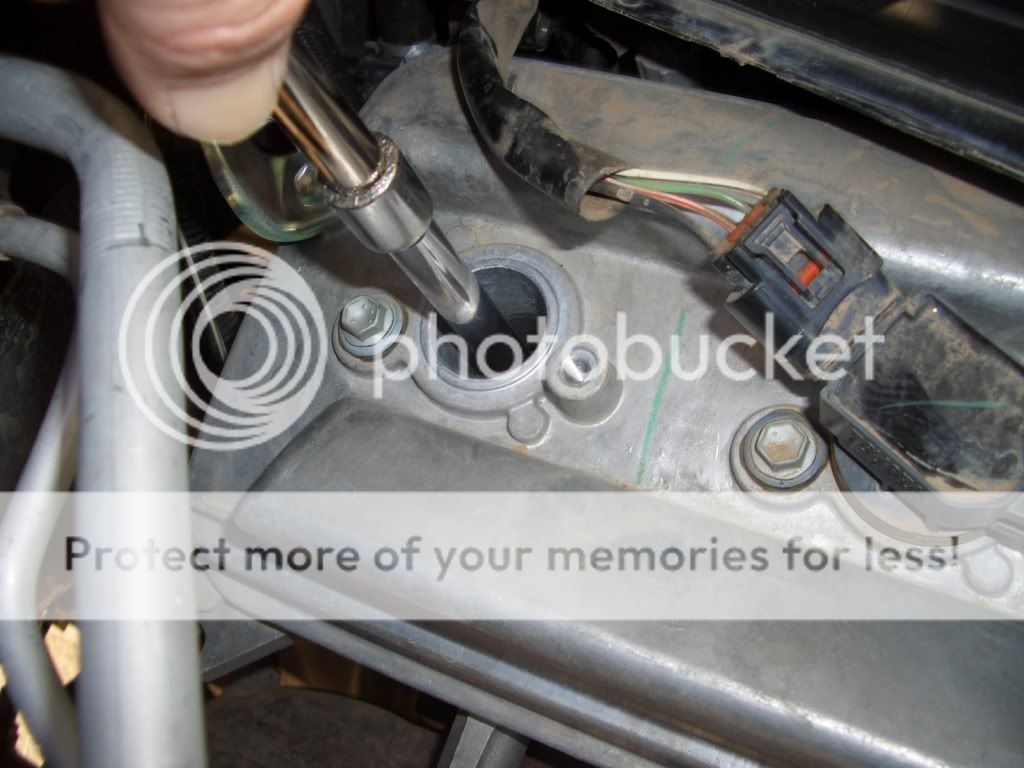
Thread the new plug in by hand. DO NOT cross thread the plug. Torque the Plug to 15 ft-lbs.

Reinstall the coil:
Plug the Harness back in until you hear it “snap”:
2 more and the passenger side is finished. 
the Driver side has a few more things in the way. For the most part, they can be pushed out of the way.
First, you want to move this bracket (surge tank stay) by removeing the top 12mm bolt, then loosening the bottom 12mm bolt.
Then, Remove the vent hose:
Then, Remove the VSV connector, and the clip holding the wireing in the way:
Its tight, But take your time…
If its your first time changeing the plugs, you will notice that the Driver Side has NGK, and the passenger has Denso Plugs. Toyota has been doing this for eons, and I really cant confirm why they do this. Useing 6 Denso plugs is what I recomend.
After all the plugs are installed, Make sure the coil harnesses are plugged in propperly, and the coils are all bolted back to the valve cover. Then, reconnect the Vent hose, then the VSV connector, and the Surge Tank Stay. Reinstall your Air intake, and filter houseing, and the engine cover. Make sure all tools are accounted for. Then, Start your truck. Drive to the store, and get your self your favorite beverage. Come back home, and enjoy your beverage knowing you just saved a ton of cash. 
When your finished, Check your old plugs to see how they are.
This is what you want them to look like. Make sure they are dry, with no oil, no white, and not too dark. 
http://www.ngksparkplugs.com/techinf…q/faqread2.asp

Normal Condition
An engine’s condition can be judged by the appearance of the spark plug’s firing end. If the firing end of a spark plug is brown or light gray, the condition can be judged to be good and the spark plug is functioning optimally.

Dry and Wet Fouling
Although there are many different cases, if the insulation resistance between the center electrode and the shell is over 10 ohms, the engine can be started normally. If the insulation resistance drops to 0 ohms, the firing end is fouled by either wet or dry carbon.

Overheating
When a spark plug overheats, deposits that have accumulated on the insulator tip melt and give the insulator tip a glazed or glossy appearance.

Deposits
The accumulation of deposits on the firing end is influenced by oil leakage, fuel quality and the engine’s operating duration.

Lead Fouling
Lead fouling usually appears as yellowish brown deposits on the insulator nose. This can not be detected by a resitsance tester at room temperature. Lead compounds combine at different temperatures. Those formed at 370-470°C (700-790°F) having the greatest influence on lead resistance.

Breakage
Breakage is usually caused by thermal expansion and thermal shock due to sudden heating or cooling.

Normal Life
A worn spark plug not only wastes fuel but also strains the whole ignition system because the expanded gap (due to erosion) requires higher voltages. Normal rates of gap growth are as follows:
Four Stroke Engines: 0.01~0.02 mm/1,000 km (0.00063~0.000126 inches/1,000 miles)
Two Stroke Engines: 0.02~0.04 mm/1,000 km (0.000126~0.00252 inches/1,000 miles)

Abnormal Erosion
Abnormal electrode erosion is caused by the effects of corrosion, oxidation and reaction with lead – all resulting in abnormal gap growth.

Melting
Melting is caused by overheating. Mostly, the electrode surface is rather lustrous and uneven. The melting point of nickel alloy is 1,200~1,300°C (2,200~2,400°F).

Erosion, Corrosion and Oxidation
The material of the electrodes has oxidized, and when the oxidation is heavy it will be green on the surface. The surface of the electrodes are also fretted and rough.

Lead Erosion
Lead erosion is caused by lead compounds in the gasoline which react chemically with the material of the electrodes (nickel alloy) as high temperatures; crystal of nickel alloy fall off because of the lead compounds permeating and seperating the grain boundary of the nickel alloy. Typical lead erosion causes the surface of the ground electrode to become thinner, and the tip of the electrode looks as if it has been chipped
More info:
http://www.4strokes.com/tech/sparkplg.asp
You can tell a lot by reading your spark plug. Here’s how to check your jetting by reading the plug. Always start with a new plug that is of proper heat range and reach. Using a plug with an improper heat range or incorrect reach can cause engine damage or poor performance. Proper torque is essential as an improperly tightened plug can damage the engine. Before removing any plug, clean the area around it thoroughly to prevent debris from entering the cylinder. A dry acid brush and an air compressor work great. Run the engine at least 10 minutes, as a new plug will not color immediately.
To obtain an accurate reading from a new spark plug:
- Accelerate at full throttle on a straight
- Push the engine stop button and pull the clutch lever in to release the clutch
- Coast to a stop
- Remove the spark plug
 Center ElectrodeSide ElectrodePorcelain Insulator
Center ElectrodeSide ElectrodePorcelain Insulator
It is best to use a magnifying glass to inspect the spark plug. The porcelain insulator (1) around the center electrode (2) should appear clean and colorless with a gray ring around the center electrode where it exits the porcelain. Metallic specks indicate lean jetting that is removing metal from the piston. Black sooty streaks on the porcelain indicate rich jetting.
ConditionPlug AppearanceMixtureNormalWhite (no color change) with light gray ringCorrectOverheatingExtreme white with aluminum specsLeanWetWet or sootyRich
In addition to improper jetting:
- A lean condition can be caused by air leaks in the inlet tract or exhaust system, passing of too much air because of the use of the wrong air filter, use of a less-restrictive aftermarket exhaust system, or leaks in the air box.
- A rich condition can be caused by a plugged or dirty air filter, use of a more-restrictive aftermarket exhaust system, a clogged spark arrester, or excessive oil on the air cleaner. Excessive smoking may occur with this condition.
An article from our Forums:
Reading spark plugs isn’t too hard to do, but I’ve read various understandings of how to read spark plugs and it seems there’s different schools of thought on this. I always use a lighted magnifying glass of 5X to 10X to better see the tiny deposits. When checking your spark plug, always use a good used spark plug, making sure it’s not worn out. A worn out spark plug will have a worn or rounded center electrode and or side electrode. New spark plugs are hard to read accurately for mixture checks, but if you have to use a new spark plug, then make sure to put at least 15 to 20 hard minutes on it before attempting to get a reading. I do my spark plug readings from the base ring at the bottom of the threaded body. The ‘L’ shaped grounded side electrode that’s welded to the base ring will clue you into the heat range as this is the closest part to the piston. The porcelain will clue you into timing and preignition/detonation issues while the base ring will clue you into the mixture. Many people I’ve talked to and some of the articles I’ve read simply look at the porcelain color and use that as their sole guide for a proper air/fuel mixture, but I don’t agree with that all together and would not recommend basing your jetting decisions solely on the color of your spark plugs porcelain.
Center/Ground Electrode
You want to first carefully look at the grounded side electrode to determine if you’ve got the proper heat range for your spark plug and this is done by closely examining the color change of the side electrode. If the color of the electrode changes near its end where it sits over the center electrode, then the spark plug heat range is too cold and what you’re seeing is the color changing due to the heat transferring too quickly. If the color of the side electrode changes color near where it’s welded to the base ring, then your spark plug is too hot and what you’re seeing is a slower heat transfer from the side electrode to the base ring, resulting in preignition/detonation issues and most of the deposits will be burned off. Ideally, you want the side electrode of your spark plug to change color at about the half way point, about where it makes it’s ‘L’ shaped bend.
Base Ring
The second thing you want to check is your spark plugs base ring and this will clue you into how your bike is jetted. The color of the base ring itself is close in color to the crown of the piston and what you’re looking for here is a nice light to medium brown color all the way around the base ring. If you’re seeing a chalky whitish or light grayish color or the color doesn’t uniformly go all the way around the ring, then you are running too lean. If the color does go all the way around the ring, but you see dark colored soft dry soot that’s heavily spotted on top of the base ring color, then you’re running too rich and or possibly have a spark plug with too cold of a heat range. The presence of wet oil or ash deposits is a tell tale sign of possible engine problems such as valve stem or valve guide wear or worn out piston rings, etc, so don’t confuse this with a rich mixture that leaves your spark plug carbon fouled.
Porcelain Color
The third thing to check is the porcelain color and this will clue you into preignition/detonation issues. What you’re looking for are tiny specs of aluminum on the porcelain, which can be either black or shiny. If the tip of the insulator appears melted, then this is yet another clue to a pre-ignition/detonation problem. The detonation is caused by the air/fuel mixture exploding instead of burning and you may hear the resulting knocking sound from this, particularly when the engine is under a load. The knocking sound heard is actually a shock wave that’s disrupting the boundary layer of cooler gasses that cover the internal parts of the combustion chamber, resulting in incomplete combustion. This rapid rise in pressure and temperature exerts extreme force on engine components and can do very bad things such as crack your engines head, crack or put holes in your piston, blow head gaskets, break your connecting rod, damage bearings, seals, etc. This is why you should not base all your jetting decisions on just the porcelain color alone because the porcelain color doesn’t tell the whole story. Although the porcelain and base ring colors are similar, the porcelain usually appears lighter in color when compared to the base ring.


 Posted in
Posted in  Tags:
Tags: 











